
Navigating Online Meeting Fatigue: Strategies for Zoom and Beyond
Online meetings can be both a blessing and a curse. Here’s how we think you should handle them to make them more the former than the latter.
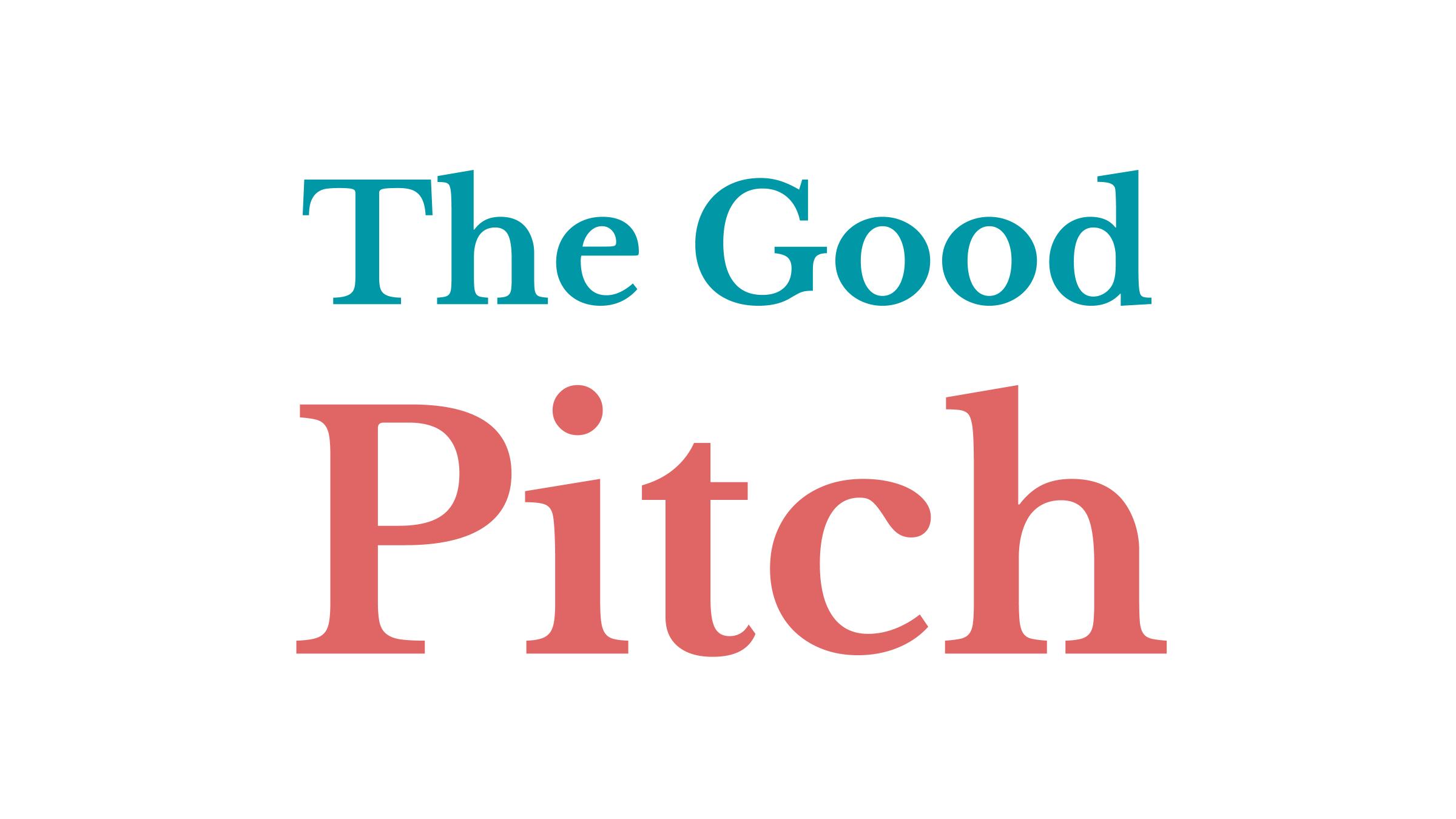
In the brand communication market, usually Clients create a competition (or Pitch), inviting more agencies, and then select the right Agency partner assigning them a campaign, or a new brand identity, or the yearly digital plan, and so on. If a “good pitch” will be lead, that will be a good opportunity for both, Client and Agency. If not, it could be turn into an absolutely negative experience, and again, for both parts. This article aims to share useful guidelines, and advices, on how to set up and deal a pitch in a respectful and efficient way.
Each pitch is different. However they have in common some basic rules. For example, brief and output have to be achievable in terms of budget and timeline. The final decision to work together may be taken by both sides. Usually the decision process has not only one direction, like Client picks Agency. Indeed, also the Agency is in the position of choosing its Clients, for several kind of reasons.
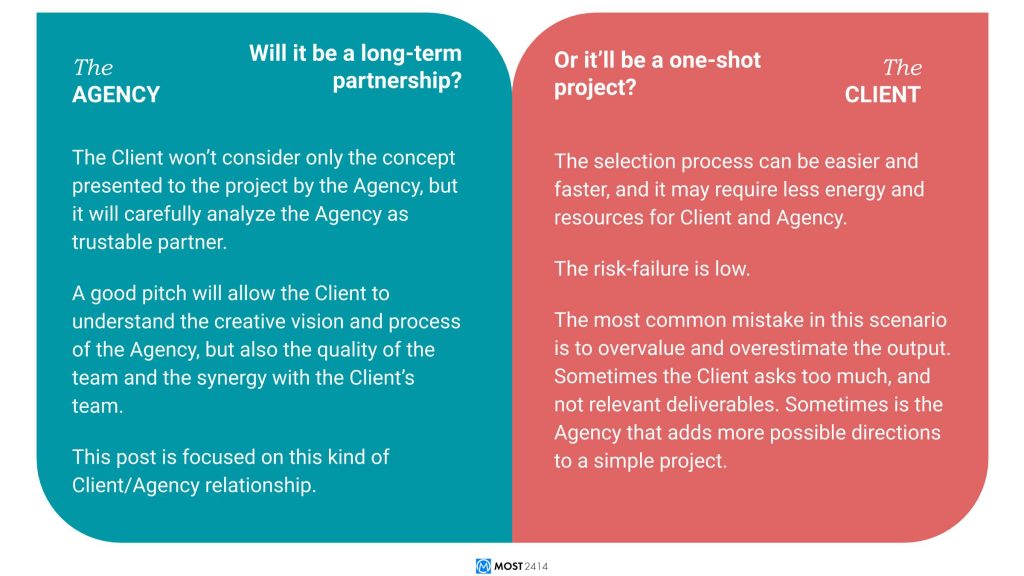
Before to fire the incumbent Agency, the Client should understand what is going on wrong with the Agency. What are the problems? Have they any concern on how is the communication Client/Agency? Is the Agency in the right condition to perform the services demanded? Sometimes to give answers to such questions could save a business relationship. In any case, to be able to understand this issue, it will help in the future how to build a relationship with a new Agency.
Maybe both teams know each other quite well (they have worked together in the past, for example), and the relationship is still good and the Client trusts to the Agency. So why to invite other Agencies to a pitch?
It can happen that an Agency would like to introduce themselves before a possible pitch, and the Client may feel a positive chemistry that may consider to assign Agency at least a trial project. Many business relationships start in this way.
When the Client decides to test directly the Agency, a workshop between the two teams could help to understand if the Client has chosen the right Agency, or not.
Another interesting option, even if not always applicable, is to assign the Agency to a small project. In this way, the Client could valuate how the Agency works before giving a bigger project. The Client could apply the same method also to other Agencies before to take a final decision.
Dear Client,
Do you think that working on a pitch has costs only for the Agencies? Think about that. You too are investing relevant resources. Consider the time spent:
And if you invite more agencies, the time spend will be much more. Of course also a direct assignment to an Agency, without pitch, implies spending time, obviously it would be easier to manage.
Client and Agency have to be sincere and honest since the beginning about two topics: “what I need” and “what I can do”. If the expectations of the Client are clear, it will be easier for the Agency to follow them. If the skills of the Agency are transparent, it will be easier for the Client to choose. In case both parts are not sincere about these two topics, it’s highly probable that they are going to waste time.
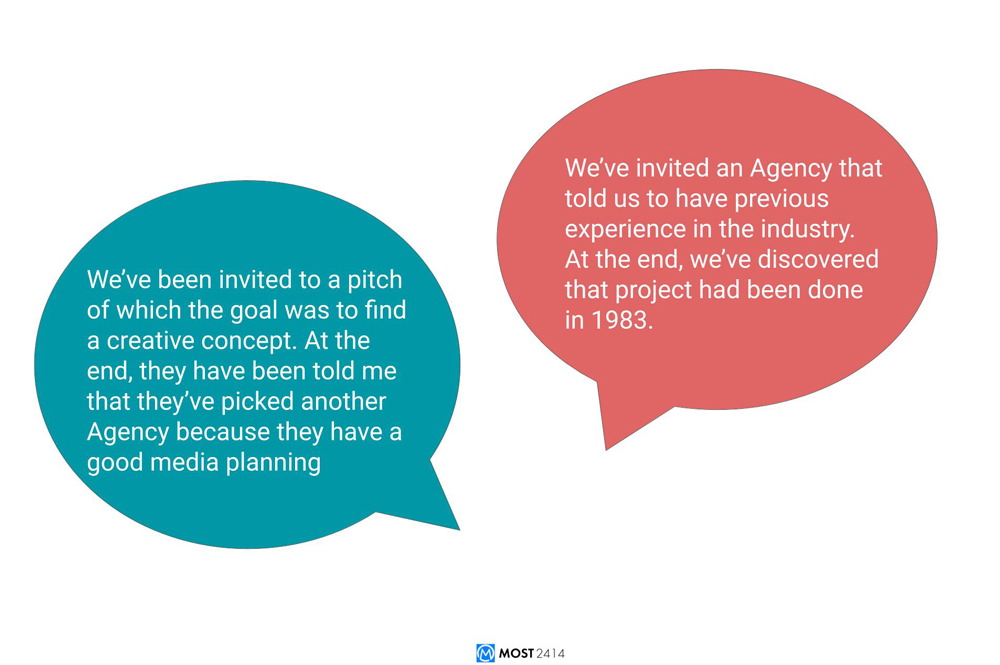
Inviting more Agencies to a pitch doesn’t mean that you, Client, can ask whatever and whenever you want. The Agencies that are working on their pitch presentation are investing time and resources to elaborate a project for you. Also for this reason, they deserve utmost respect. And from the other side, having been invited to a pitch is a commitment to take seriously and professionally.
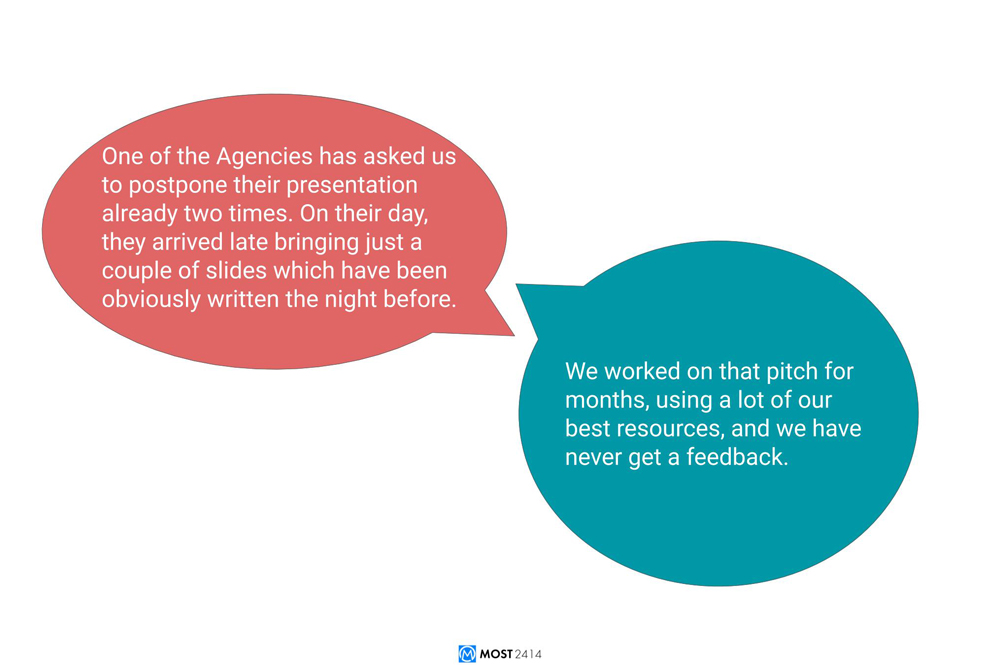
A good pitch process takes time, energy, money and human resources. This is why an Agency should be aware clearly about the deliverables requested by the Client, as the Client should be aware in advance on the capabilities of the Agency.
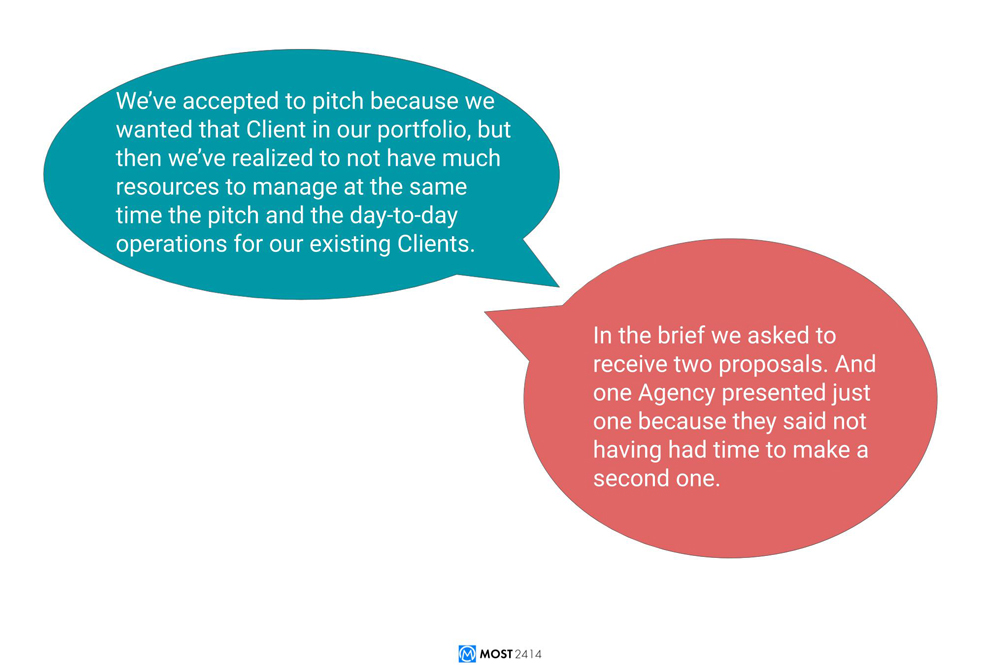
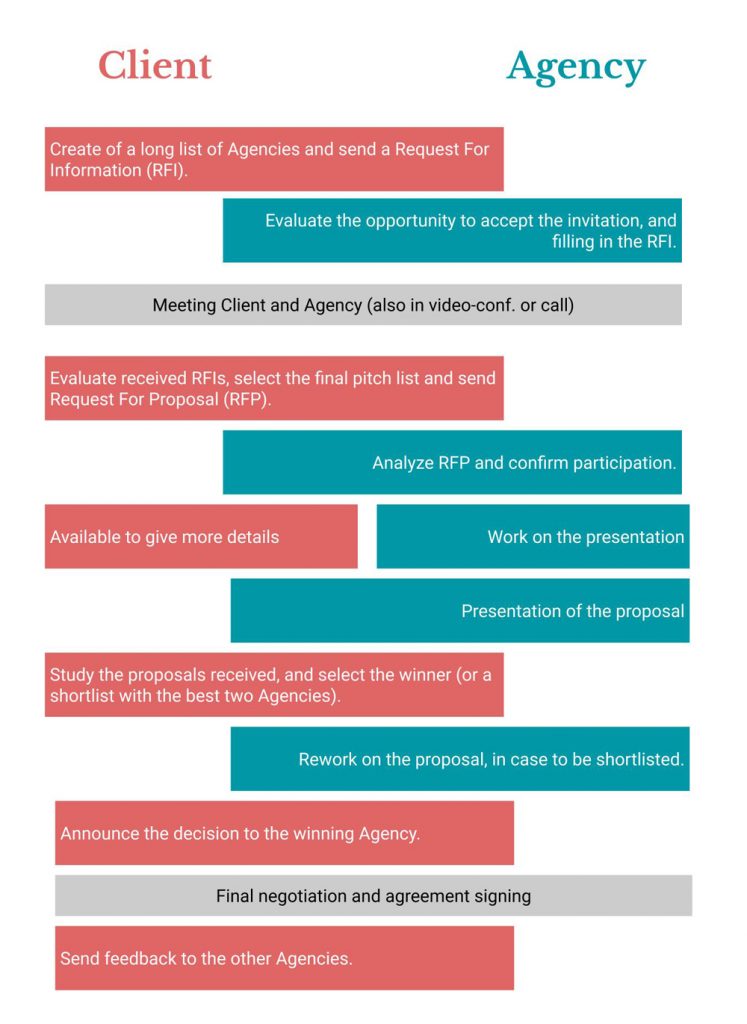
Client – If you don’t know already the name of the three, four Agencies to invite to your pitch, it would be good to create a long list of potential players. How?
Agency – You know that Clients, who are seeking Agencies for a collaboration, will search online first. So, you know that if your website is weak or misleads your skills, you may lose opportunities. What should you do?
Client – As soon as your research is completed, and got replies to the RFI, it’s time to meet the Agencies. Obviously it’s not necessary that you invite all of them. You should have already eliminated some from the long list. It would be recommended to meet them at their office first, asking to see their credentials. Then you should pick, in general, three Agencies. Four, if you want to invite also your current Agency, the incumbent. Send them the RFP.
Agency – It’s time to introduce yourself the best you can to the Client. Be honest and transparent. Show them only the case studies relevant for the Client and the project you may be invited to pitch. This is a good moment also to get more information about the Client, its products, services, team, and more. You know better than anybody else your potentialities, so consider carefully if you can accept the invitation to pitch. Better to be sincere, and not be scary to say “no thanks”. It’s true that you can decide after received the RFP, but sometimes better to not waste time.
Let’s make a step back first, and let’s talk shortly about what is called the RFI, Request for Information. The RFI is a like a job description. So, let’s say that a HR Manager of a corporation wants to receive only CV matching with the job description. This is why the JD has to be precise, detailed and clear. Same for a Client that is waiting RFP from Agencies. These are the basic information that a Client should share with all the Agencies.
And these are the informations that the Agency should send to the Client:
Now the Client is ready to send the RFP to the three (or four) selected Agencies. What should be included in the RFP?
The meaning of “Brief” is brief. It should be short, precise, and direct to point.
Writing down a good brief might not be so easy. The team of the Client needs to know very well the brand, what they want for the project, and what they expect from the Agency.
Here are some useful questions that the Client should ask themselves before. They may sound too abstract, but probably they could a good initial point to develop a brief.
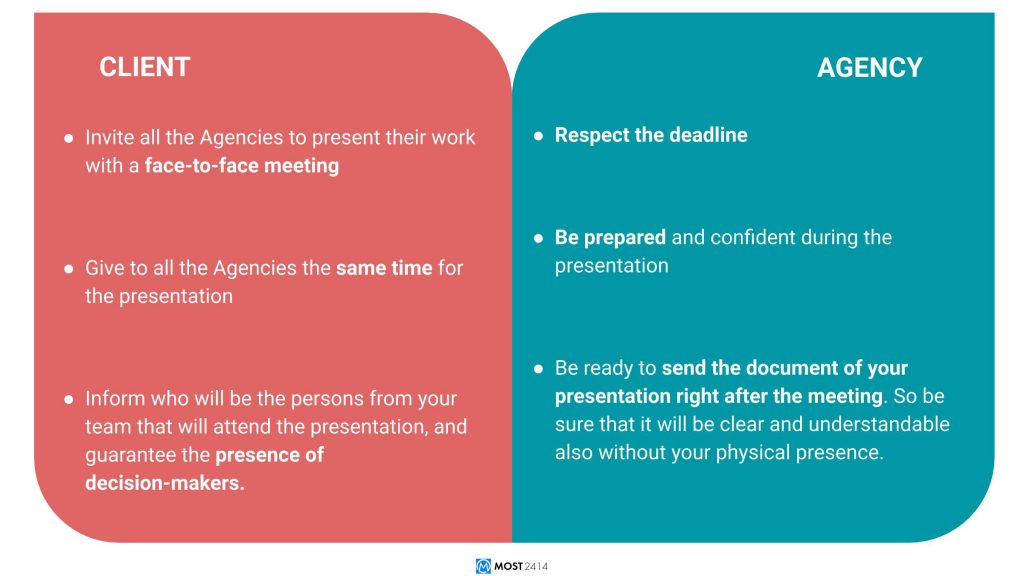
After the presentations, it is possible that the Client selects two Agencies. It will starts an in-depth phase where the Agencies have not to prepare a second presentation. But they might be asked to revise their idea in some specific part. Maybe part of the brief has been changed, or the Client got new insights.
The Client should be very clear and specific about what they want to be revised. Then the Agencies should get a timeline aligned to the amount of work that the Agencies are going to do.
If not agreed previously, during this phase, the Agencies may consider to ask (or the Client to propose) the coverage of expenses incurring for the pitch.
The communication of the outcome should proceed as indicated in the RFP. Like the Agency attends the presentation at the established date, also the Client should respect the timeline.
The negotiation with the winning Agency should start meanwhile the pitch process is still open. Indeed, the pitch will be considered closed only after winning Agency and Client has signed an agreement.
Immediately after communicating the outcome to the winning Agency, it is very important that the Client gives feedback to the other agencies, motivating the reasons why they lost the pitch.
The team of the Agency will be inducted to in-depth understanding of the Client’s world: background history, culture and values, products and services, strong and weak points.
If the handover is from an Agency to another, it is necessary to consider a certain period of time for information exchanging. The relationship between the Agencies, during this phase, should be collaborative for the sake of the client.
If respect, clarity and transparency were well conducted during the pitch phase, this kind of relationship should keep going on. It may be normal if doubts and complications will arise during the partnership. So it is recommended to keep an open dialogue between the teams.

Online meetings can be both a blessing and a curse. Here’s how we think you should handle them to make them more the former than the latter.

Learn how to leverage brand awareness for increased sales and business growth. Unlock the power of branding to maximize revenue potential.

Live Commerce หรือก็คือ ‘ไลฟ์สดขายของ’ ที่เติบโตสุดๆ ในโลกยุคดิจิตอล แต่อะไรกันแน่ที่ทำให้คนชอบดู ชอบช้อปในไลฟ์?
1015/29 Sukhumvit 71 Road,
Watthana, Bangkok 10110
©2024, MOST 2414 Co., Ltd. • VAT No. 0105558155913 • Terms & Conditions • Privacy Policy • PDPA • Sitemap
| Cookie | Duration | Description |
|---|---|---|
| cookielawinfo-checbox-analytics | 11 months | This cookie is set by GDPR Cookie Consent plugin. The cookie is used to store the user consent for the cookies in the category "Analytics". |
| cookielawinfo-checbox-functional | 11 months | The cookie is set by GDPR cookie consent to record the user consent for the cookies in the category "Functional". |
| cookielawinfo-checbox-others | 11 months | This cookie is set by GDPR Cookie Consent plugin. The cookie is used to store the user consent for the cookies in the category "Other. |
| cookielawinfo-checkbox-necessary | 11 months | This cookie is set by GDPR Cookie Consent plugin. The cookies is used to store the user consent for the cookies in the category "Necessary". |
| cookielawinfo-checkbox-performance | 11 months | This cookie is set by GDPR Cookie Consent plugin. The cookie is used to store the user consent for the cookies in the category "Performance". |
| viewed_cookie_policy | 11 months | The cookie is set by the GDPR Cookie Consent plugin and is used to store whether or not user has consented to the use of cookies. It does not store any personal data. |